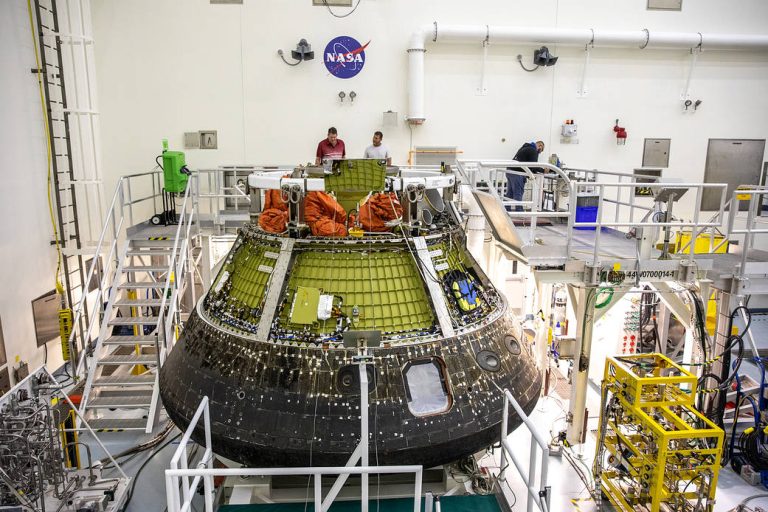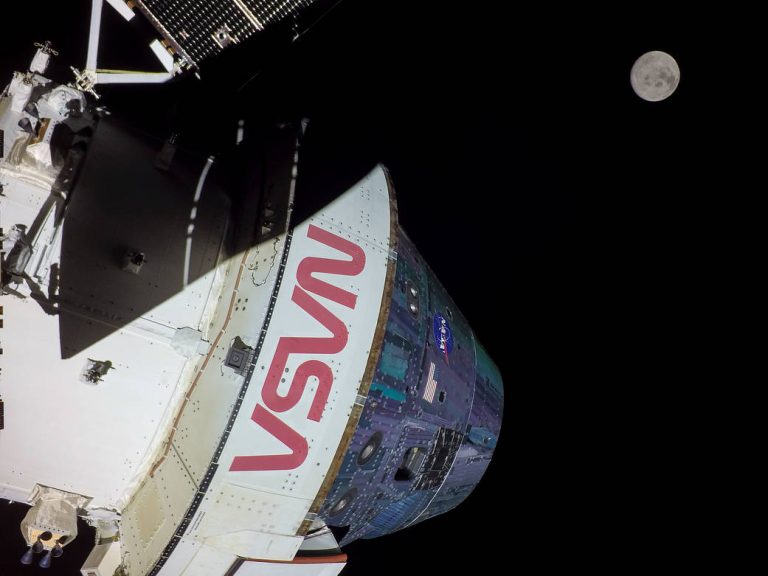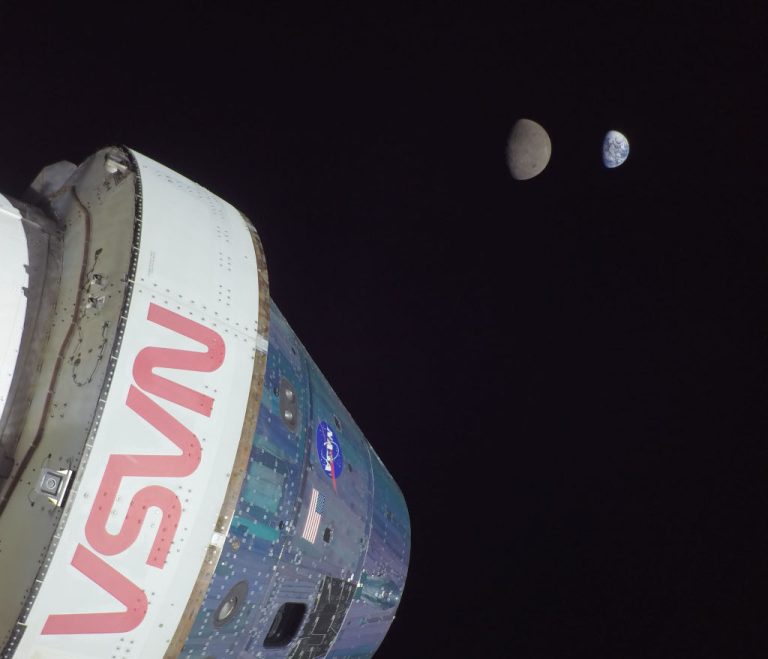猎户座飞船视角的地落
See Explanation. Clicking on the picture will download the highest resolution version available.
请参阅说明。单击图片将下载可用的最高分辨率版本。

See Explanation. Clicking on the picture will download the highest resolution version available.
请参阅说明。单击图片将下载可用的最高分辨率版本。

2024年1月24日 Earth and Moon from Beyond Image Credit: NASA, Artemis I; Processing: Andy Saunders Explanation: What do the Earth and Moon look like from beyond the Moon? Although frequently photographed together, the familiar duo was captured with this unusual perspective in late 2022 by the robotic Orion spacecraft of NASA‘s Artemis I mission as it looped around Earth’s most massive satellite and looked back toward its home world. Since our Earth is about four times the diameter of the Moon, the satellite’s seemingly large size was caused by the capsule being closer to the smaller body. Artemis II, the next launch in NASA’s Artemis series, is currently scheduled to take people around the Moon in 2025, while Artemis III is planned to return humans to…

2023年11月30日 Artemis 1: Flight Day 13 Image Credit: NASA, Artemis I Explanation: On flight day 13 (November 28, 2022) of the Artemis I mission, the Orion spacecraft reached its maximum distance from its home world. Over 430,000 kilometers from Earth in a distant retrograde orbit, Orion surpassed the record for most distant spacecraft designed to carry humans. That record was previously set in 1970 during the Apollo 13 mission to the Moon. Both Earth and Moon are in the same field of view in this video frame from Orion on Artemis I mission flight day 13. The planet and its large natural satellite even appear about the same apparent size from the uncrewed spacecraft’s perspective. Tomorrow’s picture: galaxy rise 阿尔忒弥斯1号:任务的第13天 影像提供: NASA, Artemis I 说明:…

Snoopy, the zero gravity indicator that flew aboard Orion during the Artemis I mission, wears a smile after being unpacked from his transport case on Jan. 5, 2023. Zero gravity indicators are small items carried aboard spacecraft that provide a visual indicator when a spacecraft has reached the weightlessness of microgravity. NASA has held an association with Snoopy since the Apollo Era – the character has contributed to the excitement for NASA human spaceflight missions, helping inspire generations to dream big, and is a symbol of NASA’s safety culture and mission success. Image Credit: NASA/Isaac Watson 2023年1月5日,在阿尔忒弥斯1号任务中搭载猎户座的零重力指示器史努比从他的运输箱中取出后面带微笑。 零重力指示器是航天器上携带的小物件,在航天器达到微重力失重状态时提供视觉指示器。自阿波罗时代以来,NASA就与史努比建立了联系——史努比这个角色为NASA载人航天飞行任务带来了兴奋,帮助激励了一代又一代人的梦想,也是NASA安全文化和任务成功的象征。 影像来源:NASA/Isaac Watson

The Artemis I Orion capsule is secured on a platform inside the Multi-Payload Processing Facility (MPPF) at Kennedy Space Center in Florida in this image from Jan. 6, 2023. Orion splashed down on Dec. 11, 2022 and was transported back to Kennedy for de-servicing inside the MPPF. During Orion’s 25.5-day trip beyond the Moon and back, it flew farther than any designed to carry humans to deep space and safely return them to Earth, paving the way for human deep space exploration and demonstrating NASA’s commitment and capability to extend human presence to the Moon and beyond. Image Credit: NASA/Ben Smegelsky 在这张2023年1月6日拍摄的照片中,阿尔忒弥斯1号猎户座太空舱被固定在佛罗里达州肯尼迪航天中心的多有效载荷处理设施(MPPF)内的平台上。猎户座于2022年12月11日溅落,并被送回肯尼迪,在MPPF内部进行维修。 在猎户座飞船25.5天的往返月球之旅中,它的飞行距离超过了任何旨在将人类带到深空并安全返回地球的飞行距离,为人类的深空探索铺平了道路,并展示了NASA将人类存在延伸到月球和月球外的承诺和能力。 影像来源:NASA/Ben Smegelsky

An osprey is seen in front of NASA’s Space Launch System rocket with the Orion spacecraft aboard as launch preparations continued Friday, Sept. 2, 2022, at NASA’s Kennedy Space Center in Florida. This photo was chosen by the NASA Headquarters photographers as one of the best from 2022. See the rest on Flickr. Image Credit: NASA/Keegan Barber 2022年9月2日,星期五,在佛罗里达州的NASA肯尼迪航天中心,一只鱼鹰出现在NASA太空发射系统火箭前,火箭上载有猎户座飞船,发射准备工作继续进行。这张照片被NASA总部的摄影师选为2022年的最佳照片之一。在Flickr上查看更多内容。 图片来源:NASA/Keegan Barber

On flight day 20 of the Artemis I mission, Dec. 5, 2022, Orion captured the Moon on the day of return powered flyby, the final major engine maneuver of the flight test. The burn, which used the spacecraft’s main engine on the European-built service module, lasted 3 minutes, 27 seconds, and changed the velocity of the spacecraft by about 655 mph (961 feet per second). It also committed the spacecraft to a Dec. 11 splashdown, which will air live on NASA Television, our website, and the NASA app. Follow Orion’s journey by visiting the Artemis I blog. Image Credit: NASA 2022年12月5日,在阿尔忒弥斯1号任务的第20天,猎户座在返回动力飞越的当天拍摄了月球得照片,这是飞行测试的最后一次主要发动机机动。这次点火使用了欧洲制造的服务舱上的航天器主发动机,持续了3分27秒,使航天器的速度改变了约655英里/小时(961英尺/秒)。它还承诺将在12月11日进行航天器溅落,届时将在NASA电视、我们的网站和NASA应用程序上直播。 通过访问阿尔忒弥斯1号博客,关注猎户座的旅程。 图片来源:NASA

On the 19th day of the Artemis I mission, Dec. 4, 2022, a camera mounted on the Orion spacecraft captured the Moon just in frame as Orion prepared for its return powered flyby on Dec. 5, when it passed approximately 79 miles above the lunar surface. Orion performed the return powered flyby burn at 11:43 a.m. EST, changing the velocity of the spacecraft by approximately 655 mph (961 feet per second). The return powered flyby is the last large maneuver of the mission, with only smaller trajectory corrections to target Earth remaining. Follow Orion’s journey by visiting the Artemis I blog. Image Credit: NASA 在阿尔忒弥斯1号任务的第19天,也就是2022年12月4日,当猎户座准备于12月5日进行返回动力飞掠月球表面约79英里时,安装在猎户座飞船上的相机拍摄到了月球。 猎户座在美国东部时间上午11:43执行了返回动力飞掠点火,将航天器的速度改变为大约655英里/小时(每秒961英尺)。返回动力飞掠是任务的最后一次大型机动,只剩下对目的地地球较小的轨迹修正。 通过访问阿尔忒弥斯1号博客,关注猎户座的旅程。 影像来源:NASA

2022年11月21日,在阿尔忒弥斯1号任务的第六天,猎户座飞船的光学导航相机拍摄到了月球下方陨石坑的黑白图像。这张照片和其他拍摄到的照片是自阿波罗号以来从载人飞船上拍摄的离月球最近的照片。光学导航相机以不同的相位和距离拍摄地球和月球的黑白图像;这项技术演示将有助于证明其在未来载人任务中的有效性。

2022年12月1日 Artemis 1: Flight Day 13 Image Credit: NASA, Artemis 1 Explanation: On flight day 13 (November 28) of the Artemis 1 mission the Orion spacecraft reached its maximum distance from Earth. In fact, over 430,000 kilometers from Earth its distant retrograde orbit also put Orion nearly 70,000 kilometers from the Moon. In the same field of view in this video frame from flight day 13, planet and large natural satellite even appear about the same apparent size from the uncrewed spacecraft’s perspective. Today (December 1) should see Orion depart its distant retrograde orbit. En route to planet Earth it will head toward a second powered fly by of the Moon. Splashdown on the home world is expected on December 11. Tomorrow’s picture: pixels in…